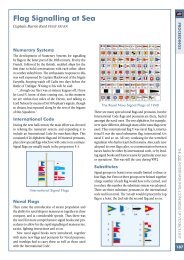The International Brigades in the Spanish War ... - The Flag Institute
The International Brigades in the Spanish War ... - The Flag Institute
The International Brigades in the Spanish War ... - The Flag Institute
Create successful ePaper yourself
Turn your PDF publications into a flip-book with our unique Google optimized e-Paper software.
PROCEEDINGS<br />
144<br />
Fig. 9<br />
Georgi Dimitrov (Kovachevtsi, Bulgaria, 1882 -<br />
1949). He became a pr<strong>in</strong>ter and was an active trade<br />
unionist. Elected to parliament as a socialist, he<br />
campaigned aga<strong>in</strong>st <strong>the</strong> country’s <strong>in</strong>volvement <strong>in</strong> <strong>the</strong><br />
First World <strong>War</strong>.<br />
In 1923 he led a failed communist upris<strong>in</strong>g <strong>in</strong><br />
Bulgaria. At his trial Dimitrov defended himself so<br />
effectively that he was acquitted.<br />
In 1934, Dimitrov moved to <strong>the</strong> Soviet Union<br />
where he worked as secretary-general of Com<strong>in</strong>tern.<br />
In September 1936 <strong>the</strong> Com<strong>in</strong>tern began organis<strong>in</strong>g<br />
<strong>the</strong> formation of <strong>International</strong> <strong>Brigades</strong>.<br />
With <strong>the</strong> help of <strong>the</strong> Soviet Union a communist<br />
government was established <strong>in</strong> Bulgaria after <strong>the</strong><br />
Second World <strong>War</strong>. Georgi Dimitrov became Prime<br />
M<strong>in</strong>ister until his death on 2 July 1949.<br />
1.5. <strong>The</strong> Rakosi Group<br />
Formed by Hungarian people. Came out to <strong>the</strong> Aragon<br />
front <strong>in</strong>tegrated <strong>in</strong>to <strong>the</strong> “Columna de Ferro”.<br />
In April 1937 <strong>the</strong>y entered <strong>the</strong> “Carlos Marx” battalion.<br />
This flag is ~1.20 x 1.40m, white (or gold?) over red<br />
(Fig. 10).<br />
Fig. 10<br />
Matyas Rakosi (Ada 1892 - Gorki 1972). Formed<br />
<strong>the</strong> Hungarian Communist Party, toge<strong>the</strong>r with Bela<br />
Kun. In 1919 he emigrated to Austria and Moscow.<br />
He was one of <strong>the</strong> secretaries of <strong>the</strong> Comm<strong>in</strong>tern<br />
(1921-1924). Arrested <strong>in</strong> Hungary <strong>in</strong> 1925, he was<br />
condemned to hard labour for life. Changed <strong>in</strong> 1940<br />
by some flags captured <strong>in</strong> 1849 by <strong>the</strong> Tzar troops<br />
<strong>in</strong> Hungary! In 1945 he came back to Hungary. Vice-<br />
President of <strong>the</strong> Council (1945), General Secretary<br />
of <strong>the</strong> Communist Party (1948-1956) and President<br />
of <strong>the</strong> Council (1952-1953). With <strong>the</strong> change aga<strong>in</strong>st<br />
Stal<strong>in</strong> he was withdrawn from <strong>the</strong> Party (1956) and<br />
went to <strong>the</strong> USSR. Rakosi died <strong>in</strong> 1972.<br />
1.6. Italian Anarchists<br />
<strong>The</strong> Batallón de la Muerte or Centuria Malatesta was<br />
<strong>the</strong> best known and spectacular <strong>in</strong>ternational anarchist<br />
column. Formed by Italians, exiled <strong>in</strong> France, <strong>in</strong> <strong>the</strong>ir<br />
parade <strong>in</strong> Barcelona (March 3, 1937) <strong>the</strong>y caused a great<br />
impression because of <strong>the</strong>ir uniforms, like fascist ones.<br />
Vicente Guarner, Chief of <strong>the</strong> Aragon Army from March<br />
1937, <strong>in</strong> his book “Cataluña en la Guerra de España”<br />
(Ed. G. del Toro) gives us his impression of <strong>the</strong> anarchists<br />
columns “Giustitia e Libertá” and <strong>the</strong> “Batallón de la<br />
Muerte”. He expla<strong>in</strong>s that <strong>the</strong>y were tra<strong>in</strong>ed <strong>in</strong> a “Masia”<br />
of Sant Adrià de Besós; equipped and f<strong>in</strong>anced by <strong>the</strong><br />
Generalitat through petition of Diego Abad de Santillán<br />
and commanded by Camillo Berneri. <strong>The</strong>y entered <strong>in</strong><br />
battle with failure <strong>in</strong> Almudevar and Montalban; and <strong>in</strong> <strong>the</strong><br />
assault to <strong>the</strong> Santa Quiteria chapel, <strong>the</strong>y were annihilated.<br />
Guarner says that <strong>the</strong> rests of <strong>the</strong> battalion were<br />
<strong>in</strong>corporated <strong>in</strong> <strong>the</strong> Garibaldi and <strong>the</strong> Ascaso Division<br />
and o<strong>the</strong>rs to cross <strong>the</strong> border to France.<br />
<strong>The</strong>y used two flags ~ 1 x 1m (Figs. 11 and 12) <strong>the</strong><br />
letters UHP are <strong>the</strong> capital letters of an anarchist motto:<br />
“Unidos, Hermanos Proletarios”.<br />
Fig. 11<br />
Fig. 12






